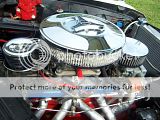wsa111":1y200x1f said:
I have seen where new fuel pumps have close to 7# psi.
I missed the point that the problem exists on both carbs.
Just install a pressure regulator & set it to 4# psi area. That should do the trick. Bill
A normal factory 144 to 200 cubic inch 1-bbl carb shouldn't ever need pressure regulating. However, some fuel pumps are off the shelf designs which may be based on V8 pumps, and have significantly more flow and pressure than the original.
I'm with Bill, if you've struck out twice, your third option is to limit fuel pressure, but you shouldn't have to if the carbs are the 100% American designs.
That's it. One thing. With white box supplier outsourcing the way it is, some replacement fuel pumps might be on the upper edge of original fuel pressure and flow specification. Bill has always said if its a traditional US Holley (US Autolite/Motorcraft 1-bbl or 2-bbl) then good fuel pressure is important. His rationale is that's how the US engineers did it, why limit pressure? I respect that point of view. I personally believe (based on two separate sources) that winding down pressure without flow restriction takes the load of the needle and seat, and allows finer control of float level, and thats based on fuel consumption GM and the Vizard company APT did on carburettor rough road simulators. (That's of little relevance to us here, but its why I recommend the lowest pressure that still allows the float and seat to work properly. Bill has always said in his experience, he wouldn't start limiting fuel pressure ever on a US carb.)
Normally, leaking is ALWAYS a foreign Holley/Weber 2-bbl 5200 to 6500 kind of thing, and also a down draft Solex/Zenith and Weber import 1-bbl kind of thing. On those, you just take the fuel pressure down to 3.5 psi max with a regulator that doesn't take out the fuel flow. Solex/Pierburg carbs (downdraft 1 and 2-bbl import carbs found on Opels, Volvos and some other Europeans vehicles) also suffer from this. I had a 78 hp 1958 2.3 liter Vauxhall with a Zenith 34VNT that leaked fuel
all the time unless the Malapasi inline fuel pressure regulator was fitted, and the fuel pressure wound down to 3 psi. Typical of the utter crap that the English and Europeans got away with forcing on the non American world for over 50 years. Thankfully, proper American designed carbs are always designed to take a bit of pressure, leaking fuel is always a foreign carb problem.
A point of note. Sometimes, the leak is the upstream flare into the carb, and its seen as a carb leak.
See this post.
 http://vb.foureyedpride.com/showthread. ... -new-parts
http://vb.foureyedpride.com/showthread. ... -new-parts
83gtstang":1y200x1f said:
It definitely has issues. Any little imperfection will make it leak. Maybe a honing stone in the shape of a cone like a dremel or drill type may reshape it. Honestly with all the time you've spent on it, you could bent a new one. Just cut the end off and reflare and see if it works. That one is bad at the 11 o clock position plus the ridges all the way around.



